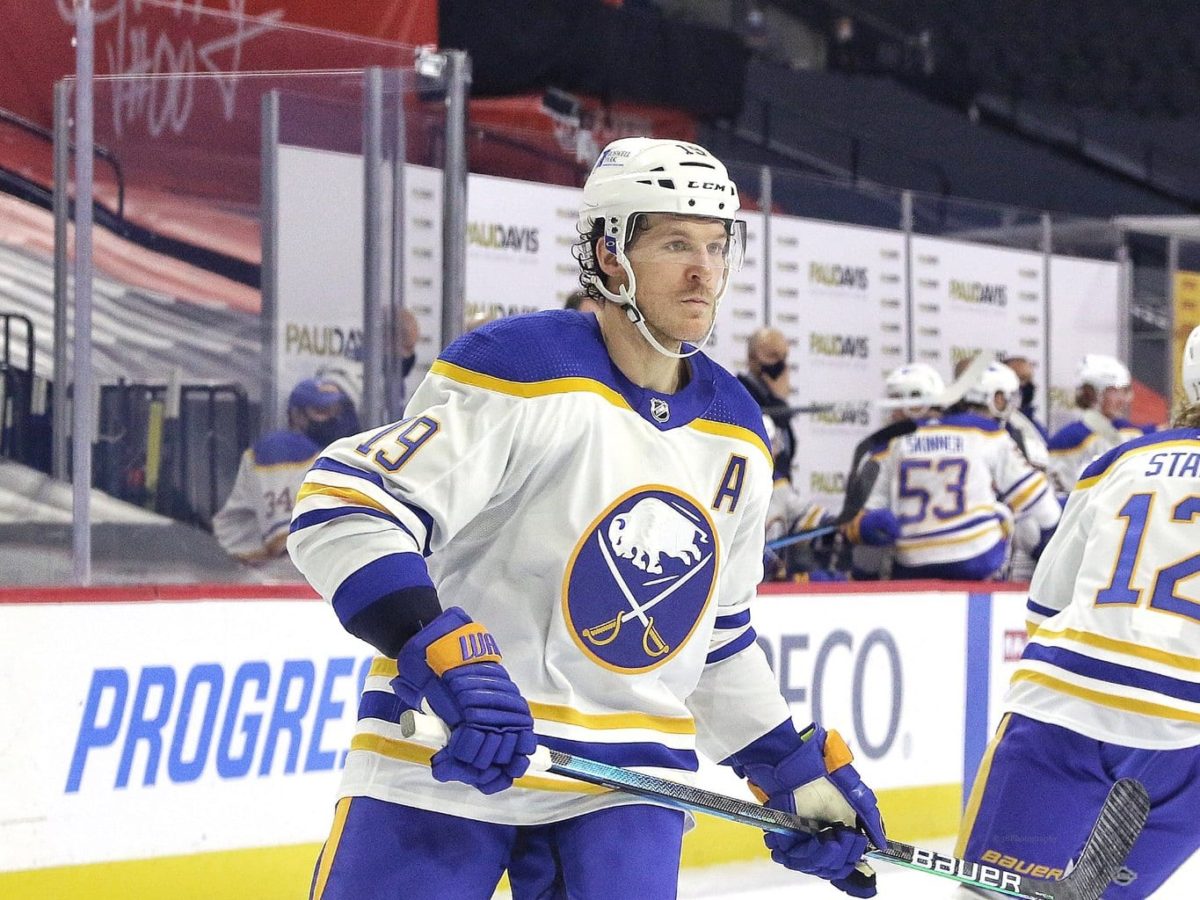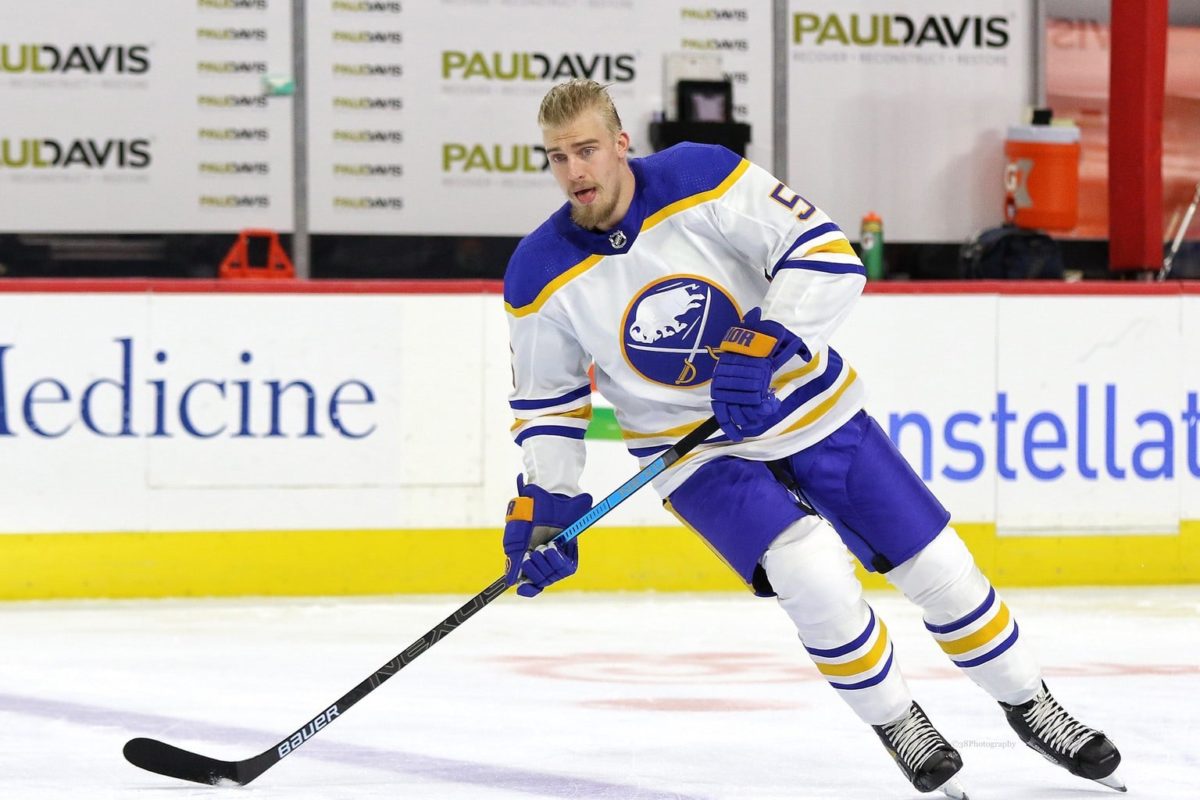The season has been underway for over two weeks now, and there are interesting storylines to follow. Players such as Bobby Ryan are leading the NHL in goal scoring, and Semyon Varlamov has a .966 save percentage (SV%) after playing four games. Sample size is always the true indication of evaluating players around the league. But there is no denying that, at this moment, the Buffalo Sabres’ top pairing of Jake McCabe and Rasmus Ristolainen has been among the best to start the season. Even the Sabres’ Twitter account is uploading graphics of their advanced stats.
To explain further, out of the sixty pairings with a minimum time on ice (TOI) of 50 minutes, the top pair ranks high in the following metrics for 5-on-5 play. When evaluating Corsi for percentage (CF%), they rank 6th out of 60 and are just behind the Josi-Ellis pair in Nashville. In terms of goals for percentage (GF%), they rank 12th out of 60 and have played the most minutes out of the 11 pairings ahead of them. Taking a look at expected goals for percentage (xGF%), and the pair ranks 6th out of 60, and they are creating a lot of scoring chances.
This article will dive into why this pairing has been so effective and the probability of this success going forward. The Sabres may finally have a reliable pairing that can slow down the other teams opposing forwards.
Why Does This Pairing Work?
McCabe has always been a good player. He is feisty, can throw big hits, and always finds a good shooting lane to create scoring chances. He appears to have helped Ristolainen feel more confident in his play driving abilities, as he is freeing up space for him.

Head Coach Ralph Krueger has been really impressed with the pairing so far, saying, “Caber and Risto are just examples for the group on a consistent basis.” Over the past two seasons, these two have played over 991 minutes together at 5-on-5, and their results were underwhelming. They didn’t work, and over a long sample size, there is reason to believe that their early-season results could regress.
Related: Sabres Prospects: 5 Amerks Players to Watch When the AHL Resumes
Why is that the case? Here are the advanced stats over the past two seasons for the McCabe and Ristolainen pairing at 5-on-5, compared to the other pairings assembled over this time. The sample size is set to a minimum TOI of 100 minutes (via Natural Stat Trick).
- CF%: 48.65 (ranked 14th out of 22 pairings)
- GF%: 42.17 (ranked 15th out of 22 pairings)
- xGF%: 50.46 (ranked 9th out of 22 pairings)
It is interesting how they were expected to score more than they actually did. At first glance, these stats would indicate that the Sabres should have explored different pairings, but them having an xGF% just above 50% showed they had some potential. They clearly have shown glimpses of handling the tough competition, and the results have come so far this season. The unknown factor is how long the positive results will last for the Sabres.
The stats may show one side of the story, but our eyes may tell another. Let’s take a few examples of the pairing in action and look at what they are doing well.
Caps’ forward Nic Dowd (#26 in white) enters the zone, and McCabe (#19 in blue) does his best to force him to the board and cause the turnover. Ristolainen (#55 in blue) reads the play well, and after Dowd sneaks by McCabe, he used his body positioning to lay a huge bodycheck. McCabe used the upper part of the board to get the puck to Curtis Lazar (#27 in blue), and he exits the zone.
This pairing is doing their job well, and are creating plenty of scoring opportunities.
Ristolainen Has Been Surprising So Far
Ristolainen has been a controversial player since entering the league in 2013. He clearly has the skill, but his on-ice results have always been negative. He looks lost a lot of the time in the defensive zone, and there have been many goals scored against the Sabres that have come from his misplays.

First, let’s look at his advanced statistics and the numbers showing through various metrics. It is then always useful to look at video footage to evaluate how these numbers come to the way they are. As Rachel Doerrie said, both are tools that should be used in player evaluations.
The following graphic is from JFreshHockey, and it showcases Ristolainen’s expected wins above replacement over his career. I am going to go over what the means and what it entails.
When looking at this graph, there is a line across the zero. That is supposed to represent replacement-level in terms of production and combining all the advanced metrics. In this example, Ristolainen has four seasons where he is below zero, meaning he was below replacement-level for those seasons. Basically, if you were to substitute him with a player at the zero or above, he would have been more likely to help his team win.
Related: Sabres Outlook After First 6 Games of 2020-21
Now, Ristolainen has scored some highlight-reel goals since entering the league, and when he shows those glimpses of offensive flashes, it makes fans more frustrated with him. He has the tools, but many of his plays come from a lack of awareness in the defensive zone.
Below are a few examples of his offensive potential and a clip of his decision-making when creating breakout passes.
When he plays like this, he can make defenders such as Brent Burns look silly. The only other defender on this team that could make this play is Rasmus Dahlin, and that shows that he has that game-breaking skill when he’s confident. The problem is there are many more examples of him making the wrong type of plays.
Even during a scrimmage, he makes a turnover at the neutral zone, resulting in a goal against his team. Take a look at 0:10 – 0:18 of the video below and how it showcases the flaws in his game.
Overall, it is still quite early in the season. The results have been promising for the pairing, and the hope is that it continues. Based on the sample size from the previous two seasons, these players are unlikely to sustain these numbers, but I suspect that they will still be effective. They need to be for this team to succeed.